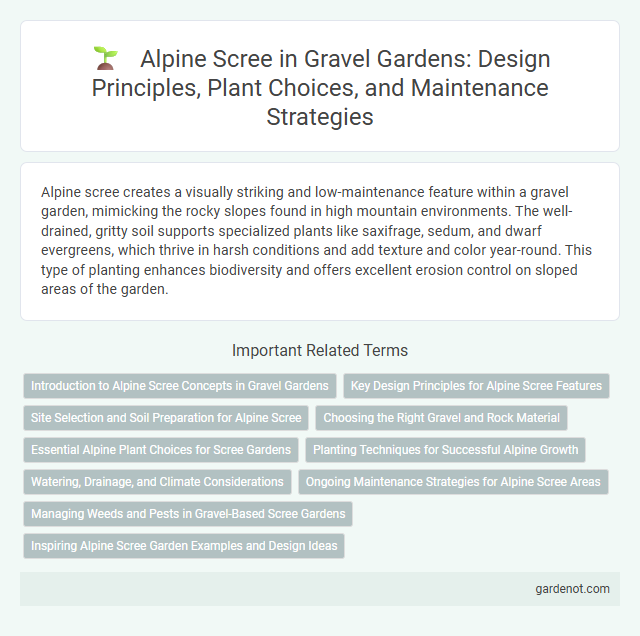Alpine scree creates a visually striking and low-maintenance feature within a gravel garden, mimicking the rocky slopes found in high mountain environments. The well-drained, gritty soil supports specialized plants like saxifrage, sedum, and dwarf evergreens, which thrive in harsh conditions and add texture and color year-round. This type of planting enhances biodiversity and offers excellent erosion control on sloped areas of the garden.
Introduction to Alpine Scree Concepts in Gravel Gardens
Alpine scree in gravel gardens mimics the natural rocky slopes found in high mountain environments, providing excellent drainage and a unique aesthetic. This landscaping method involves using crushed stones and angular gravel to create a loose, well-drained substrate ideal for drought-tolerant alpine plants such as saxifrage and sedum. Incorporating alpine scree enhances biodiversity by supporting specialized flora while adding texture and structure to garden designs.
Key Design Principles for Alpine Scree Features
Alpine scree design emphasizes well-draining soil with a mix of coarse gravel and rocky substrates to mimic natural mountain slopes, ensuring optimal root aeration and moisture control. Plant selection focuses on hardy, drought-tolerant alpine species like sedums, saxifrages, and creeping phlox, which thrive in nutrient-poor, gritty soil conditions while providing year-round texture and color. Strategic layering of rocks with varying sizes creates microclimates that protect plants from extreme weather and encourage biodiversity within the gravel garden environment.
Site Selection and Soil Preparation for Alpine Scree
Alpine scree thrives in well-drained, rocky soil with full sun exposure, making sloped sites with excellent drainage ideal for gravel gardens. Soil preparation involves incorporating coarse sand, gravel, and grit to enhance permeability and mimic natural scree conditions, preventing waterlogging. Selecting a site with minimal organic matter and good air circulation supports the growth of drought-tolerant alpine plants adapted to harsh, nutrient-poor environments.
Choosing the Right Gravel and Rock Material
Selecting the appropriate gravel and rock material is crucial for an effective alpine scree garden, emphasizing well-draining, angular stones like crushed granite or quartzite to mimic natural mountain environments. Opt for varied sizes, from fine gravel to larger rocks, to create the necessary microhabitats and assist with moisture retention and root stability. Using local or regionally sourced materials enhances authenticity and supports native plant adaptability in the alpine scree garden.
Essential Alpine Plant Choices for Scree Gardens
Essential alpine plant choices for scree gardens include Sedum, Saxifraga, and Alyssum, known for their drought tolerance and ability to thrive in rocky, well-drained soils. These plants exhibit excellent adaptability to harsh conditions, providing vibrant colors and unique textures that enhance the gravel garden's aesthetic. Selecting species native to alpine scree environments ensures optimal growth and resilience in challenging garden settings.
Planting Techniques for Successful Alpine Growth
Alpine scree planting techniques emphasize well-drained, gritty soil to mimic natural mountainous environments, ensuring healthy root development and preventing waterlogging. Selecting hardy, drought-tolerant alpine species such as saxifrage, sedum, and dianthus supports robust growth in rocky substrates. Incorporating raised beds or rock gardens with varied microclimates facilitates optimal adaptation and thriving alpine scree plants.
Watering, Drainage, and Climate Considerations
Alpine scree in gravel gardens requires well-drained soil to prevent root rot and replicate its natural rocky habitat. Watering should be minimal and infrequent, ensuring the soil dries out between sessions to mimic alpine drought conditions. Optimal growth occurs in cool to temperate climates with good air circulation, reducing moisture-related diseases.
Ongoing Maintenance Strategies for Alpine Scree Areas
Ongoing maintenance strategies for Alpine scree areas in gravel gardens focus on regular removal of invasive weeds to preserve native plant health and soil stability. Monitoring drainage patterns ensures that water does not pool, preventing root rot and erosion. Periodic inspection of rock placements helps maintain the structural integrity and aesthetic appeal of the scree environment.
Managing Weeds and Pests in Gravel-Based Scree Gardens
Effective weed and pest management in alpine scree gardens relies on selecting drought-tolerant gravel substrates that inhibit weed seed germination. Regular inspection and manual removal of invasive species like chickweed and moss prevent overgrowth that competes with native alpine plants. Incorporating beneficial insects such as ladybugs helps control aphid populations, reducing the need for chemical pesticides in these delicate, gravel-based ecosystems.
Inspiring Alpine Scree Garden Examples and Design Ideas
Alpine scree gardens showcase a stunning array of drought-tolerant, low-maintenance plants like Sedum, Sempervivum, and Saxifraga flourishing among rocky substrates to mimic natural mountainous environments. Incorporating diverse textures and heights with gravel, stones, and compact evergreens enhances both visual interest and drainage, essential for plant health. Design ideas emphasize creating layered, well-drained beds that replicate alpine conditions, supporting biodiversity while adding year-round structural appeal to gravel garden landscapes.
Alpine scree Infographic

 gardenot.com
gardenot.com